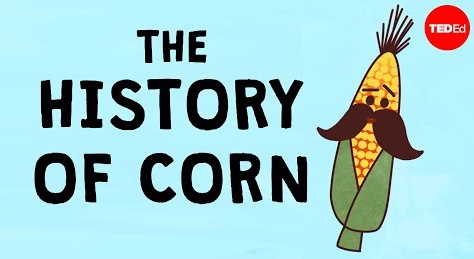Corn currently accounts for more than one tenth of our global crop production. The United States alone has enough cornfields to cover Germany.
玉米目前占全球农作物产量的1/10以上,仅美国的种植面积就足以覆盖整个德国。
But while other crops we grow come in a range of varieties, over 99% of cultivated corn is the exact same type: Yellow Dent #2.
但是,尽管我们种植的其他作物品种繁多,但超过99%的耕种玉米都是一个品种:黄马牙2号玉米。
This means that humans grow more Yellow Dent #2 than any other plant on the planet.
也就是说,人类种植的黄马牙2号玉米比地球上任何其它植物都多。
So how did this single variety of this single plant become the biggest success story in agricultural history?
那么,这类植物的单一品种如何成为农业史上最成功案例呢?
Nearly 9,000 years ago, corn, also called maize, was first domesticated from teosinte, a grass native to Mesoamerica.
约9000年前,玉米首次从中美洲的原生草玉蜀黍驯化而来。
Teosinte's rock-hard seeds were barely edible, but its fibrous husk could be turned into a versatile material.
玉蜀黍的坚硬种子几乎无法食用,但它的纤维状皮可做成用途广泛的材料。
Over the next 4,700 years, farmers bred the plant into a staple crop, with larger cobs and edible kernels.
在接下来的4700年中,农民将这种植物培育成主食,玉米穗轴更大,且谷粒可食。
As maize spread throughout the Americas, it took on an important role,
随着玉米传遍整个美洲,它发挥了重要作用,
with multiple indigenous societies revering a "Corn Mother" as the goddess who created agriculture.
被多个土著部落誉为“玉米母亲”,即创造农业的女神。
When Europeans first arrived in America, they shunned the strange plant.
当欧洲人第一次抵达美国时,他们避开了这种奇怪的植物。
Many even believed it was the source of physical and cultural differences between them and the Mesoamericans.
许多人甚至认为,这是其与中美洲人之间物质和文化差异的根源。
However, their attempts to cultivate European crops in American soil quickly failed, and the settlers were forced to expand their diet.
他们尝试在美国土地上种植欧洲农作物,但很快就失败了,这些定居者被迫扩大饮食范围。
Finding the crop to their taste, maize soon crossed the Atlantic, where its ability to grow in diverse climates made it a popular grain in many European countries.
他们发现玉米符合自己的口味后,玉米很快就抵达大西洋彼岸,玉米适应各种气候的生长的能力使其成为受许多欧洲国家欢迎的谷物。
But the newly established United States was still the corn capital of the world.
但是,新成立的美国仍然是世界玉米之都。
In the early 1800's, different regions across the country produced strains of varying size and taste.
在19世纪初期,全国不同地区生产出大小和口味各异的玉米。
In the 1850's, however, these unique varieties proved difficult for train operators to package, and for traders to sell.
然而,在19世纪50年代,对火车运营商来说,很难对这些独特品种进行包装,对商人来说,也很难出售。
Trade boards in rail hubs like Chicago encouraged corn farmers to breed one standardized crop.
芝加哥等铁路枢纽贸易委员会鼓励玉米种植者种植一种标准化作物。
This dream would finally be realized at 1893's World's Fair, where James Reid's yellow dent corn won the Blue Ribbon.
这一梦想最终在1893年的世界博览会上得以实现,詹姆斯·里德的黄马牙玉米在会上赢得了蓝丝带奖。
Over the next 50 years, yellow dent corn swept the nation.
在接下来的50年中,黄马牙玉米席卷整个美国。

Following the technological developments of World War II, mechanized harvesters became widely available.
随着二战期间的技术发展,机械收割机开始广泛普及。
This meant a batch of corn that previously took a full day to harvest by hand could now be collected in just 5 minutes.
这意味着以前人工一天所收获的玉米,现在只需5分钟就收获完毕。
Another wartime technology, the chemical explosive ammonium nitrate, also found new life on the farm.
另一种战时技术化学炸药硝酸铵,在农场也找到了新用途。
With this new synthetic fertilizer, farmers could plant dense fields of corn year after year, without the need to rotate their crops and restore nitrogen to the soil.
有了这种新的合成肥料,农民就可以年复一年地在地里密集种植玉米,无需轮作种植以恢复土壤中的氮。
While these advances made corn an attractive crop to American farmers, US agricultural policy limited the amount farmers could grow to ensure high sale prices.
尽管这些进步使玉米成为美国农民喜欢种植的作物,但为确保玉米高售价,美国农业政策限制了农民种植玉米数量。
But in 1972, President Richard Nixon removed these limitations while negotiating massive grain sales to the Soviet Union.
但是在1972年,理查德·尼克松总统取消了这些限制,同时谈判向苏联出售大量谷物。
With this new trade deal and WWII technology, corn production exploded into a global phenomenon.
通过这项新的贸易协议和二战期间的技术,玉米产量猛增成为全球现象。
These mountains of maize inspired numerous corn concoctions.
大量的玉米催生了无数玉米制品。
Cornstarch could be used as a thickening agent for everything from gasoline to glue or processed into a low-cost sweetener known as High-Fructose Corn Syrup.
玉米淀粉可用作增稠剂,从汽油到胶水都有使用,也可以加工成低成本的甜味剂,称为高果糖浆。
Maize quickly became one of the cheapest animal feeds worldwide.
玉米迅速成为全球最便宜的动物饲料之一。
This allowed for inexpensive meat production, which in turn increased the demand for meat and corn feed.
这使得肉类生产成本降低,进而增加了对肉类和玉米饲料的需求。
Today, humans eat only 40% of all cultivated corn, while the remaining 60% supports consumer good industries worldwide.
如今,人类食用的玉米仅占所有种植量的40%,而其余60%支持全球消费品行业。
Yet the spread of this wonder-crop has come at a price.
然而,这种神奇作物的传播也付出了相应代价。
Global water sources are polluted by excess ammonium nitrate from cornfields.
玉米田中过量的硝酸铵污染了全球水源。
Corn accounts for a large portion of agriculture-related carbon emissions, partly due to the increased meat production it enables.
与农业有关的碳排放中,玉米占了很大比例,部分原因是,它增加了肉类产量。
The use of high fructose corn syrup may be a contributor to diabetes and obesity.
高果糖浆的使用,可能是糖尿病和肥胖症的病因。
And the rise of monoculture farming has left our food supply dangerously vulnerable to pests and pathogens
单一农作物种植模式的兴起,使我们的食品供应极易受到病虫害和病原体的侵害,
a single virus could infect the world's supply of this ubiquitous crop.
单一病毒可能会感染这种无处不在的农作物的全球供应。
Corn has gone from a bushy grass to an essential element of the world's industries.
玉米已由丛生禾草成为世界工业的重要组成部分,
But only time will tell if it has led us into a maze of unsustainability.
但是,只有时间才能证明,它是否令我们陷入了不可持续的迷宫。


